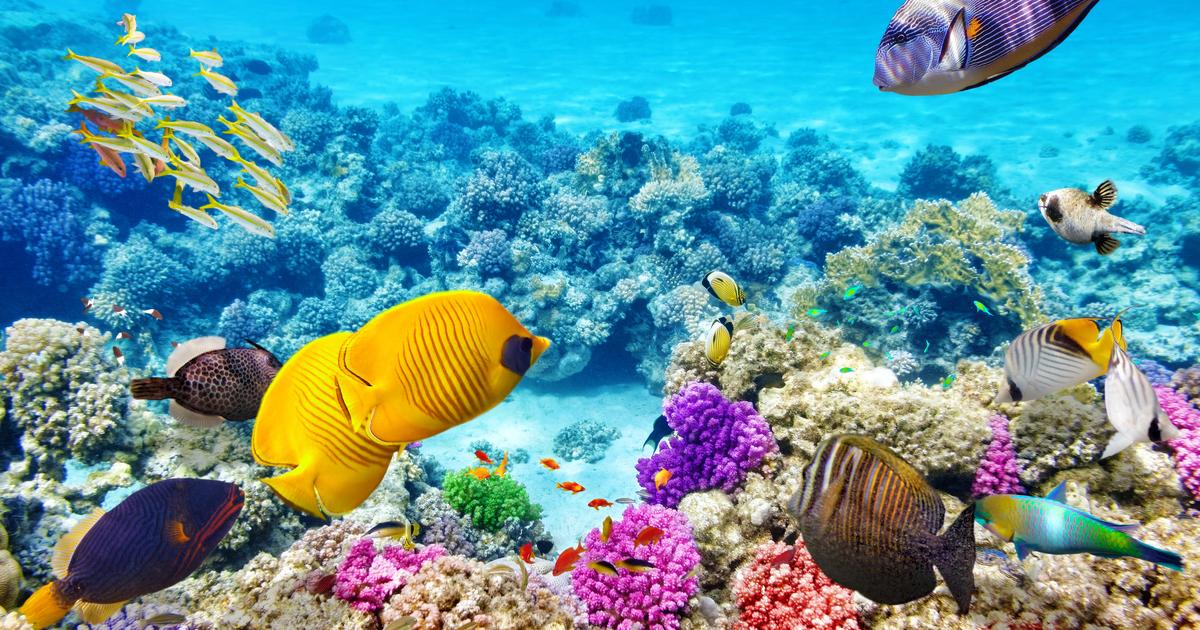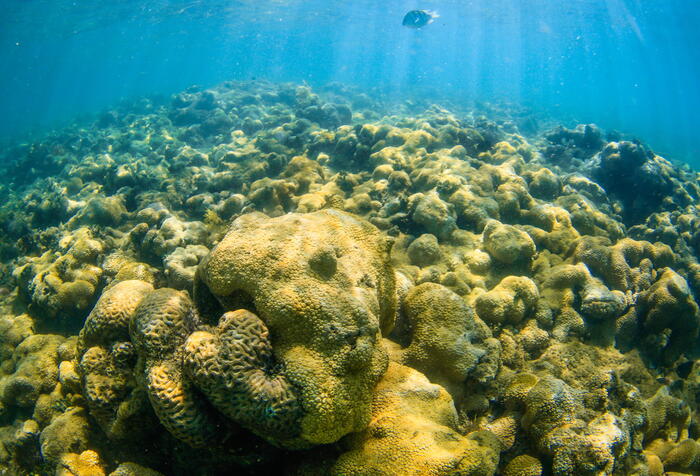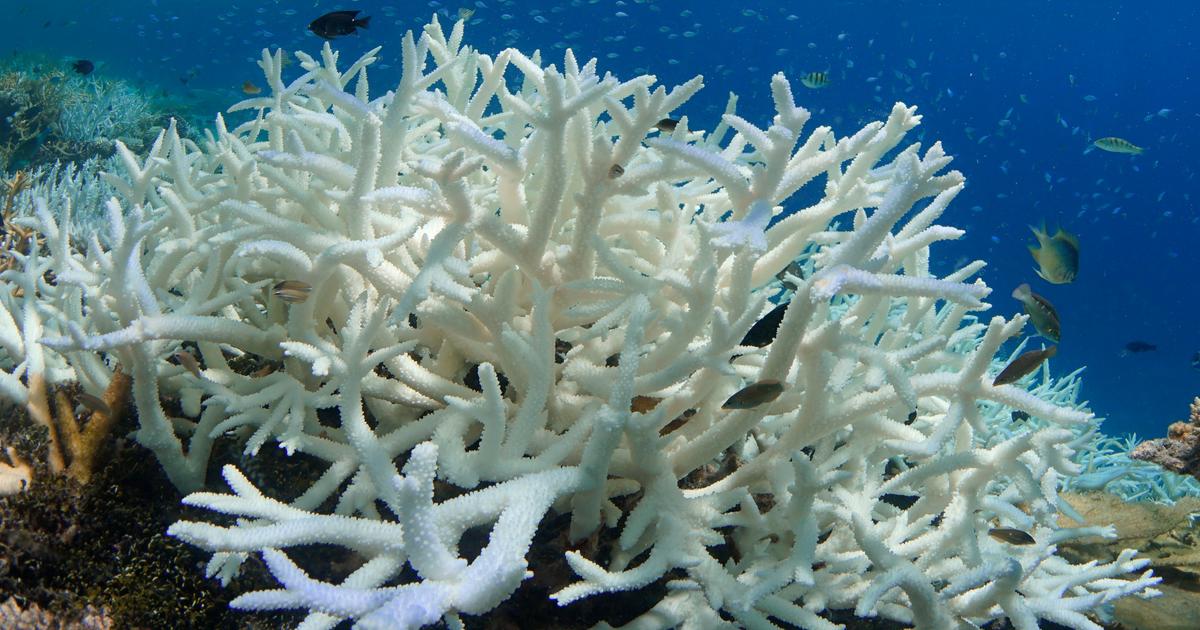Icon: enlarge
On the farm of "Coral Vita" corals grow faster than in the sea
Photo: Coral Vita
The corals should come under stress, that's what Sam Teicher and his team want.
In the water basins in which they breed the cnidarians, they turn the temperature up and down, they increase the acidity of the water.
In short: They play climate change to make the corals more resilient - so that they survive longer when they are later released into the sea.
"Corals can actually adapt well to changing environmental conditions, but they are not fast enough for climate change," says Teicher.
"We're sending the corals to the gym, so to speak."
Icon: enlarge
Sam Teicher, founder of "Coral Vita"
Photo: private
Together with his friend Gator Halpern, the 30-year-old American founded the social start-up "Coral Vita" in the Caribbean.
They want to reforest reefs - by breeding corals in farms on land, which are not only supposed to become more resistant, but also grow much faster than in nature.
They are later released into the sea again.
Icon: enlarge
Reefs like here in Fiji are not only a tourist attraction but also an underwater city for plants and animals
Photo: Mark Conlin / VWPics / imago images
The farmers' mission is a race against time.
Coral reefs around the world are threatened with extinction, and many of the ecosystems populated by fish, crustaceans, sponges and other marine life have already turned into cemeteries: only bleached skeletons are reminiscent of the earlier splendor of colors.
Corals live in a symbiosis with algae, which usually give the reefs their intense colors.
If the water temperature rises significantly, so-called coral bleaching can occur, which can lead to the corals later dying off.
If the algae are expelled from the coral tissue, all that remains is the light-colored limestone shell in which the corals live.
If the coral bleaching lasts only a short time, the tissue of the corals can take up algae cells again and continue the symbiosis.
If, on the other hand, coral bleaching occurs over a longer period of time or frequently in succession, the cnidarians can die completely and the entire ecosystem collapses.
Icon: enlarge
Many reefs worldwide only consist of bleached coral skeletons
Photo: Carl Court / Getty Images
Corals have suffered from changed environmental conditions for years, especially the rise in water temperature and acidification of the water.
But hurricanes, pesticides, fertilizers and other pollutants, overfishing or fishing with dynamite or cyanide also damage reefs.
According to Unesco, half of the world's coral deposits have already been destroyed.
The UN organization warns that the rest of the reefs could die out before the end of this century - if CO2 emissions were not reduced enough to slow down ocean warming.
Coral death affects not only around a quarter of all underwater organisms, but also around a billion people, to whom the ecosystems provide food and income.
Plants and fish multiply in the reefs, predatory fish find their food there - and people from coastal regions depend on reefs as fishing grounds and as tourist attractions.
The value of corals alone to the global tourism industry is estimated at $ 36 billion annually.
In addition, the stable structures act as breakwaters and prevent coastal areas and beaches from being eroded or flooded.
Icon: enlarge
The pilot farm of "Coral Vita" is located near the city of Freeport on the island of Grand Bahama
Photo: Coral Vita
"Reefs are not only an ecological miracle, they are also really valuable," says Sam Teicher.
Teicher, today "Chief Reef Officer" at "Coral Vita", would not have thought that he would one day become a coral farmer.
He grew up in the US capital Washington DC and was initially more interested in security politics or education.
However, he had already started diving as a child, and in college he began to grapple with climate change and its consequences.
When he discovered a coral restoration project during a break in Mauritius, he was fascinated by how coral reefs can recover.
The NGO there, however, operated traditional coral breeding: They had set up an underwater station in which coral fragments could grow in the sea - divers had to look after the cnidarians.
Teicher found the model too complex and too limited.
During his master's degree at the Yale School of Forestry and Environmental Studies, he therefore developed the concept for "Coral Vita" together with his fellow student Gator Halpern.
Icon: enlarge
Organizations around the world are experimenting with reef restoration methods - on land and underwater
Photo: Reinhard Dirscherl / OceanPhoto / imago images
Other researchers and non-profit, but also profit-oriented organizations are already growing corals on land, in laboratories or under water, but often on a smaller scale.
"Coral reef restoration is an area of growth and similar projects are happening at various levels around the world today," observes Tom Moore, director of the coral reef restoration team at the National Oceanic and Atmospheric Administration (NOAA).
"The projects show that reef restoration is possible and the successes keep growing."
With its business model, "Coral Vita" wants to scale coral farming - with a business model that is as sustainable as possible: the social start-up offers reef restoration as a service, but also markets the coral farms as a tourist attraction and organizes workshops.
Potential customers include hotel operators, governments, insurance companies, ports, cruise lines and global development organizations.
Teicher is tanned by the sun in a Skype interview, his brown hair is chin-length - he has had the past months of the pandemic on the first pilot farm of "Coral Vita" on Grand Bahama
one of the northernmost islands in the Bahamas.
The need for reef restoration is great there, according to ponds, around 80 percent of the coral reefs are dead - and tourism, but also fishing, play a major economic role.
In addition, the government was ready to support the project.
Since May 2019, the coral breeders have been putting innovative methods developed by scientists into practice on the farm - both sides benefit from the findings.
"Researchers are looking for answers to questions that can then be used by conservationists," says Kira Hughes of the Hawaii Institute of Marine Biology.
Another partner of "Coral Vita", the non-profit
Marine research institute "Mote Marine Laboratory" in Florida has succeeded in using the so-called microfragmentation method to reproduce corals up to 50 times faster than in nature - after five years the corals produced in this way were even able to have offspring themselves.
Icon: enlarge
Microfragmentation: corals are cut into square pieces - stimulating faster growth
Photo: Coral Vita
The coral gardeners of "Coral Vita" break off fragments of living corals from the area and glue the pieces on land to tiles in water basins, through which clean sea water is pumped.
There the corals continue to grow quickly and undisturbed.
"You take a fragment the size of a thumb and in six to nine months you have a coral the size of a hand," explains Teicher.
Depending on the species, the corals stay on the farm for six to eighteen months until they are large and resistant enough for the sea.
In the water basins, the farmers can regulate the environmental conditions precisely - and change the temperature, for example, in order to prepare the corals for future conditions in the wild.
more on the subject
Impending environmental disaster: cargo ship off Mauritius loses oil
Coral bleaching: Great Barrier Reef more damaged than feared
Pacific Islands: Palau bans sunscreens that poison coral
In order to reintroduce the corals to their natural habitat, Teicher and his colleagues later dive to the damaged reefs in the sea, drill holes and attach the corals to the reef with a non-toxic, waterproof adhesive, where they grow together.
Before doing this, the team inspects the areas around the reefs that are to be reforested.
In one case, for example, they had to refuse an order from a hotel - because industrial wastewater from a textile company was continuously flowing into the sea nearby.
The new corals would not have survived there either.
Reef restoration alone cannot save the corals, says Tom Moore of the US weather and oceanography agency NOAA: "On a global level, we have to drastically and quickly reduce energy consumption, switch to renewable energy sources and carbon-absorbing ecosystems such as forests, wetlands and Get mangroves, "he says.
"At the local level, we need to address threats such as overfishing and pollution, while repopulating reefs with resilient, genetically diverse and viable coral populations through restoration and novel ecological interventions."
Icon: enlarge
In the sea, the exposed corals recognize their conspecifics and connect with them
Photo: EMILY IRVING-SWIFT / AFP
In the coming year, the "Coral Vita" farm will be further expanded and the team is expected to grow to a dozen employees.
The start-up is not yet profitable; the money has so far come from investors.
The international species protection agreement CITES forbids corals to be exported across national borders.
In order to restore reefs, the cnidarians must therefore be bred on site.
Teicher and his team therefore want to set up further farms in coastal areas around the world in the future. They are currently investigating the possibilities in Barbados, Mexico or the Fiji Islands, for example.
The number of locations is in principle unlimited - because coral reefs are threatened with extinction all over the world.
Icon: The mirror
This contribution is part of the Global Society project
What is the Global Society project? Up arrow Down arrow
Under the heading Global Society, reporters from
Asia, Africa, Latin America and Europe
report on injustices in a globalized world, socio-political challenges and sustainable development.
The reports, analyzes, photo series, videos and podcasts appear in the international section of SPIEGEL.
The project is long-term and will be supported by the Bill & Melinda Gates Foundation (BMGF) for three years.
A detailed FAQ with questions and answers about the project can be found here.
What does the funding look like in concrete terms? Up arrow Down arrow
The Bill & Melinda Gates Foundation (BMGF) is supporting the project for three years with a total of around 2.3 million euros.
Is the journalistic content independent of the foundation? Up arrow Down arrow
Yes.
The editorial content is created without any influence from the Gates Foundation.
Do other media have similar projects? Up arrow Down arrow
Yes.
Major European media outlets such as "The Guardian" and "El País" have set up similar sections on their news pages with "Global Development" and "Planeta Futuro" with the support of the Gates Foundation.
Have there already been similar projects at SPIEGEL? Up arrow Down arrow
In recent years, SPIEGEL has already implemented two projects with the European Journalism Center (EJC) and the support of the Bill & Melinda Gates Foundation: The "Expedition The Day After Tomorrow" on global sustainability goals and the journalistic refugee project "The New Arrivals", as part of this several award-winning multimedia reports on the topics of migration and flight have been produced.
Where can I find all publications on Global Society? Up arrow Down arrow
The pieces can be found at SPIEGEL on the topic Global Society.








/cloudfront-eu-central-1.images.arcpublishing.com/prisa/6S7ZRJSVMJHOVNOIZWQSQ375RA.jpeg)






